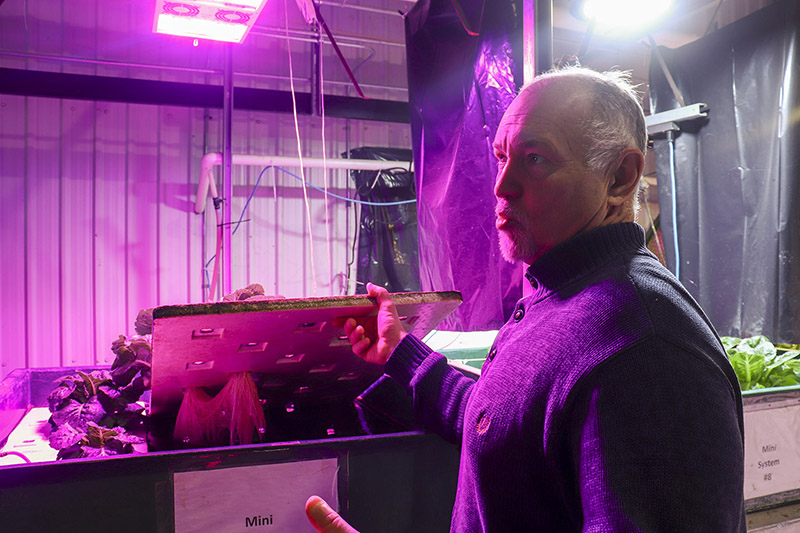Nick Savidov, PhD, senior research scientist, explains how the mini systems in the aquaponics facility work on November 18. One fish is located in a tank underneath the plants and its waste provides nutrients to the plants, which filter the water. The water has not been changed for almost 20 years, since the systems were first built.
Lethbridge College’s aquaponics research team is paving the way to sustainable agriculture – both in industry and in people’s homes.
Aquaponics is a system in which fish waste supplies nutrients to plants, which filter and purify the water that is then sent back to the fish.
The systems in the Aquaculture Centre of Excellence research facility are completely closed-loop and zero-waste, meaning nothing needs to be switched out, removed, or added after the initial setup. That is, aside from the fish when they get too big for the tank or die.
Nick Savidov, who has a PhD in Plant Physiology and Biochemistry and is a senior research scientist for the aquaponics program, said the mini systems they have were built almost 20 years ago and the water has never been changed.
“I designed them when I was still working for the government in Brooks. Those systems were moved from one location to another without changing water, fish or plants. They were moved as a whole,” he said.
The mini systems have a square tank with one fish each and plants growing above them. The plants and fish are separated, but the water travels through a pump. These plant roots grow directly in the water instead of using soil.
The full-sized system in the facility features several large tanks of 184 to 600 tilapia, separated by size, and an industrial-sized greenhouse.
The facility also houses a few aerobic bioreactors, but they are not connected to the rest of the system. These bioreactors use microorganisms to turn solid fish waste into liquid fertilizer, which is available for purchase at the Aquaculture Centre of Excellence.
Despite being filled with fish feces, which Savidov said smells significantly worse than cow or chicken manure, the bioreactors don’t stink.
Savidov said people could have small bioreactors in their homes and recycle their own excrement.
“A bioreactor is basically a modified septic tank, but it’s much more advanced in terms of recycling nutrients and food safety,” he said.
Having a personal bioreactor could cut down water usage and create nutrient-rich fertilizer for your home-grown plants.
Penny Takahashi, the aquaculture coordinator, said you could build a nice aquaponics unit at home for about $200.
“We’ve had students that have bought two totes from Walmart and made it into an aquaponic system using an aquarium pump. They’ve grown tomatoes, lettuce, everything they needed for a salad,” she said.

At the facility, they’ve grown many things such as onions, flowers, peas, beans, corn, herbs and even carrots, although Takahashi said the carrots were ugly.
She warned that if you’re doing home aquaponics, rather than having no fish, it would need to be in a temperature-regulated area like your basement or a heated garage. Due to the humidity, mold is another factor to consider.
“Tilapia could probably take summer because they can take a warm climate, but you can’t put trout into water outside because it’s going to take on the air temperature. If you get your trout to 19 or 20 degrees, you might lose them after that,” she said.
The aquaculture coordinator also said it’s important to have someone who knows what they’re doing feeding the fish and monitoring the system.
Savidov suggests taking their aquaponics micro-credentials. There are currently seven, with the eighth in progress, and two more to come after that. Savidov said the micro-credential courses are available online, are easy and use simple language, and are very affordable.
Both Savidov and Takahashi mentioned they have tours, workshops and a volunteer program for people who want to learn more about aquaponics.
“We help everybody. Big industry, small and medium sized companies, communities, we do tours for schools, we conduct workshops. We finished [a workshop] recently including First Nation groups; we are trying to involve them into aquaponics,” Savidov said.
Takahashi said one of the things the research team is currently testing is how a variety of different lights affects produce growth to find the most effective or cost-efficient light.
“Our focus is on advancing the aquaponic industry in Canada.”
She said the research will be published and available to the public once they’ve completed it.
The current work being done at the Aquaculture Centre of Excellence has come a long way from 1989 when aquaculture research first began at Lethbridge College. Their first studies were on triploid grass carp.
Savidov said he got into aquaponics because he wanted to see if the same mechanisms that govern natural ecosystems could be utilized for food production.
“My selfish scientific interests were my motivation. I wanted to know if it works,” he laughed.
He added that modern agriculture is quite efficient but not sustainable enough.
Savidov’s bioreactor design allowed for the development of Canada’s first zero-waste food production system.
For more information, go to lethbridgecollege.ca/departments/aquaculture-centre-of-excellence.

